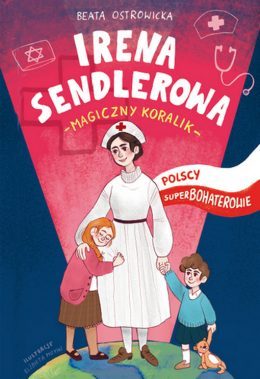Author: Beata Ostrowicka
Illustrator: Elżbieta Moyski
Year: 2018
Publisher: Wydawnictwo RM
Place of publication: Warszawa
Pages: 95
ISBN: 9788377739747
Notes: “Polish Superheroes” series

Teenage Majka and a group of her friends need to prepare a presentation for school about a selected historical hero or heroine. Without any particular interest in the project, Majka chooses number six on the list of historical people and gets Irena Sendler, about whom she knows very little. In time, Majka and the other members of the project group become increasingly invested in learning about the life and times of who they discover was a remarkable person. The author of this novel recounts the history of the Holocaust and the fates of Jewish children from the Warsaw Ghetto as well as tells the story of how Sendler was “discovered” in the 1990s by high school students in Uniontown, Kansas. She also mentions the awards and distinctions that Sendler received at the end of her life as a Righteous Among the Nations.
Beata Ostrowicka’s story allows her readers to learn about the life and activities of Irena Sendler from the perspective of its young protagonists who – similar to the characters in Wszystkie lajki Marczuka (All of Marczuk’s Likes)– get involved in a historical project and keep discovering new facts about their subject. Although Sendler’s biographies abound, Ostrowicka finds a way not to idealize her, and gives her young reader a glimpse of the dispute whether all deeds attributed to Sendler did in fact take place. Antoni, Majka’s classmate, expresses a critical attitude to the past (perhaps inspired by Anna Bikont’s 2017 biography Sendlerowa. W ukryciu [Sendler: In Hiding]), pointing to inaccuracies in the woman’s story. This way, Ostrowicka seems to encourage young readers to treat historical sources and journalistic opinion critically as they may present people and events from Polish story in a one-dimensional way.
Bibliography:
- Rybak, K., Dzieciństwo w labiryncie getta. Recepcja mitu labiryntu w polskiej literaturze dziecięcej o Zagładzie, Warszawa 2019 (pp. 14–15, 106);
- Rybak, K., Stosunki polsko-żydowskie i Zagłada w polskiej literaturze dziecięcej XXI wieku, [in:] Stosunki polsko-żydowskie, vol. 2, Kultura. Literatura, sztuka i nauka w XX wieku, ed. Z. Trębacz, Warszawa 2020, pp. 171–187 (p. 179);
- Rybak, K., Zagłada i ideologia w polskiej literaturze dziecięcej XXI wieku, „Narracje o Zagładzie”, no. 1(7), 2021, pp. 155–173 (p. 159, fn. 18);
- Rybak, K., Obrazowanie Zagłady. Narracje holokaustowe w polskiej literaturze XXI wieku dla dzieci i młodzieży, Warszawa 2023.